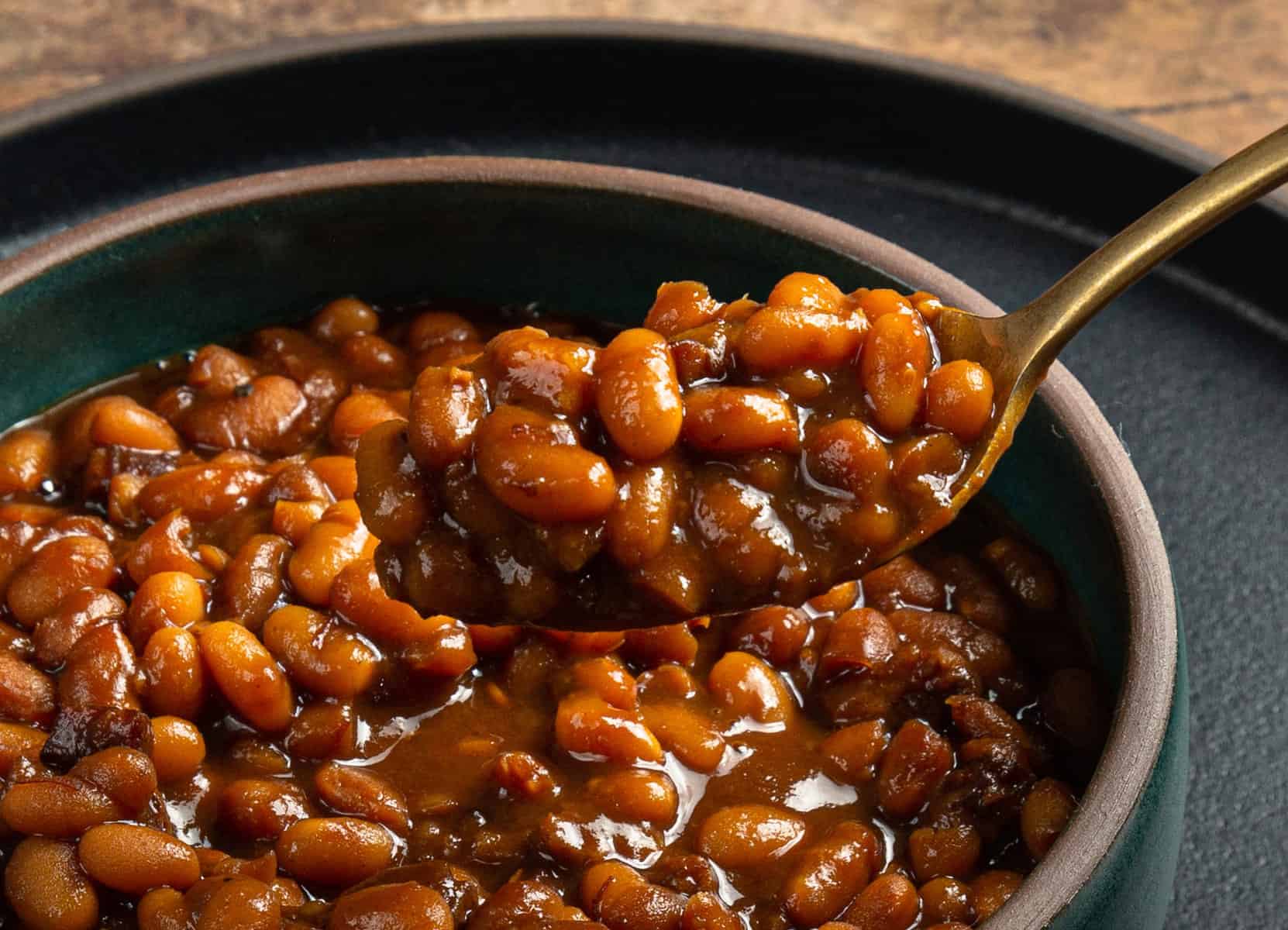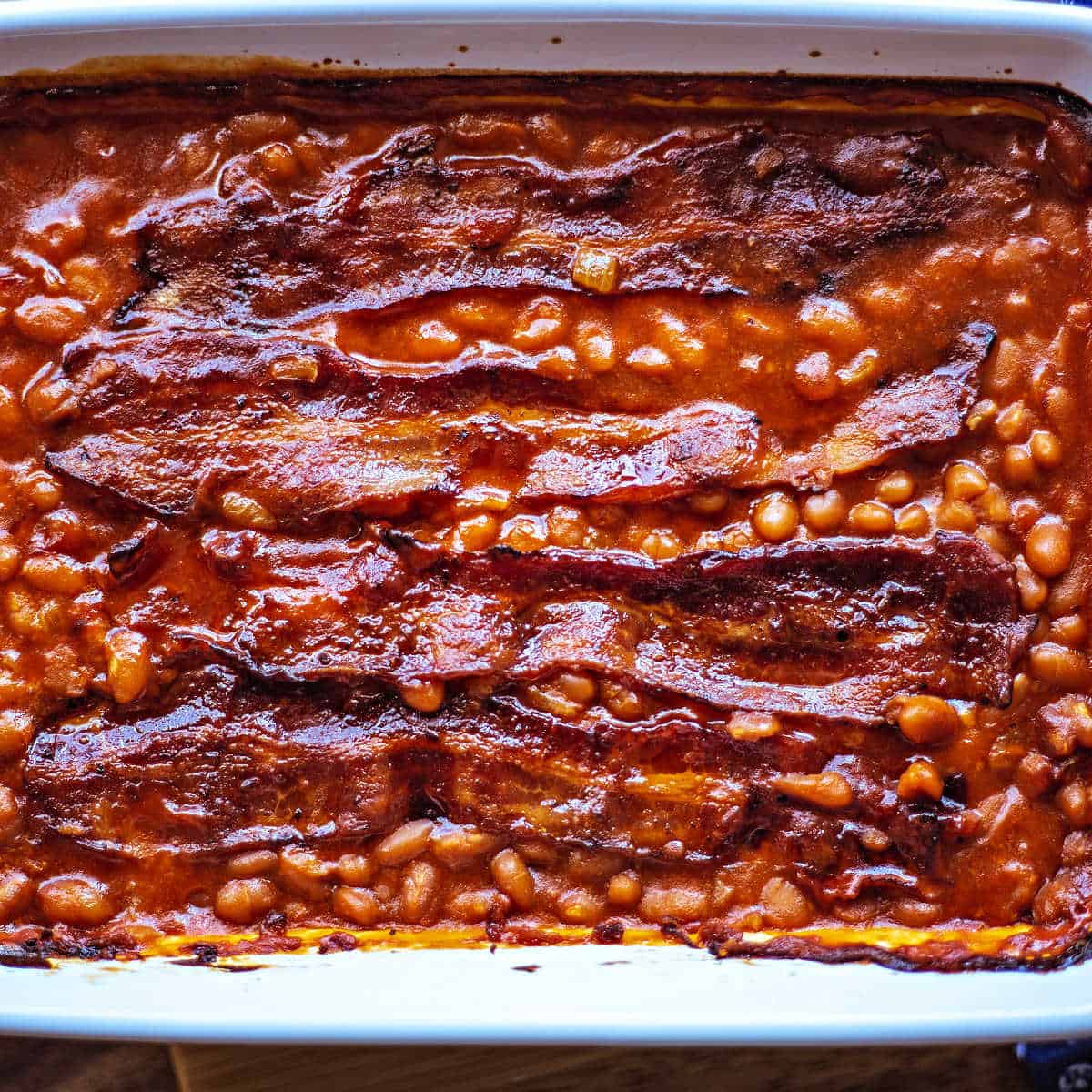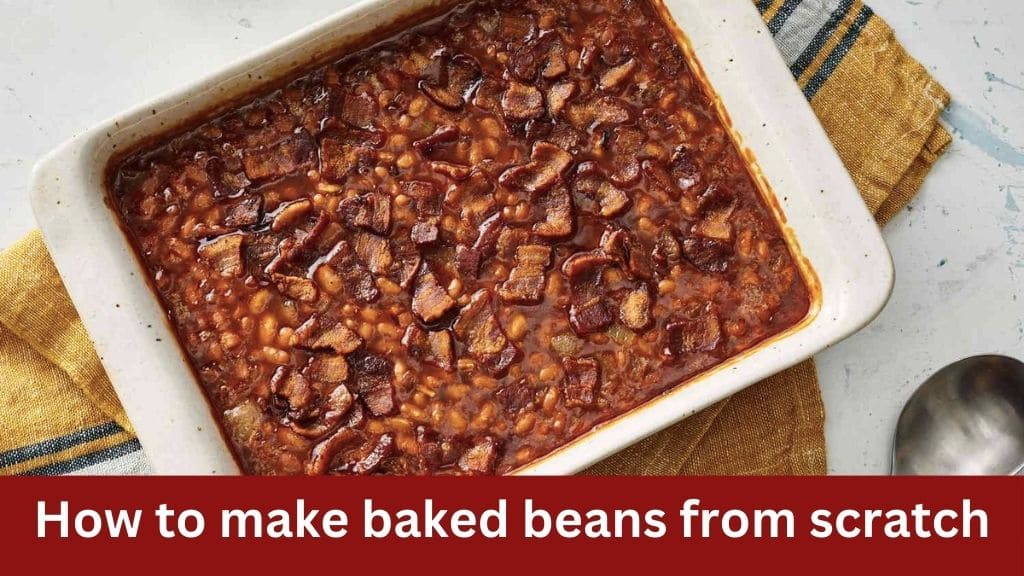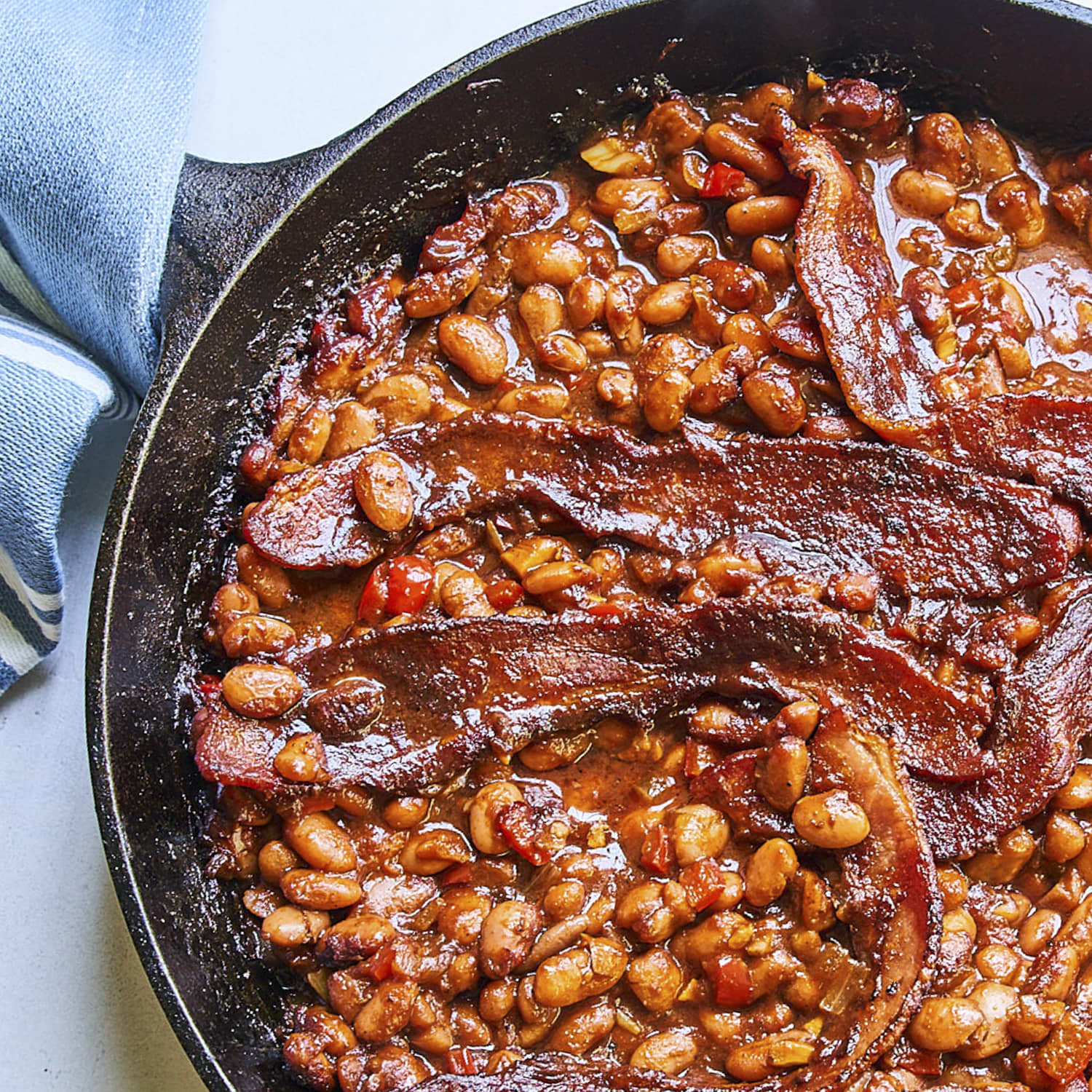Baked beans are a beloved side dish in many households, offering a delicious combination of hearty beans, savory bacon, and sweet, tangy sauce. While canned baked beans are convenient, making them from scratch allows you to control the ingredients and customize the flavor to your liking. In this comprehensive guide, we’ll walk you through the process of making baked beans from scratch, step by step.
Introduction
Baked beans from scratch offer a depth of flavor and texture that canned beans simply can’t match. By using dried beans and a few simple ingredients, you can create a dish that’s perfect for barbecues, picnics, or cozy family dinners. In this guide, we’ll cover everything you need to know to make delicious baked beans from scratch in your own kitchen.
Ingredients

Before you begin, gather the following ingredients:
- 1 pound dry navy beans
- 2 teaspoons salt
- ¼ teaspoon baking soda
- 8 slices bacon, diced
- 1 cup diced yellow onion
- 1 cup brown sugar
- 1 cup ketchup
- 2 tablespoons maple syrup
- 2 tablespoons apple cider vinegar
- 1 ½ cups reserved bean liquid
Preparation

1. Soak the Beans
- Measure the Beans: Start by measuring out the desired quantity of dry navy beans. For this recipe, you’ll need 1 pound of dry beans.
- Rinse the Beans: Place the dry beans in a colander or sieve and rinse them thoroughly under cold running water. This helps to remove any dirt or debris.
- Place in a Large Pot: Transfer the rinsed beans to a large pot or bowl. Make sure the pot is large enough to accommodate the beans and allow room for them to expand as they soak.
- Cover with Water: Pour enough cold water over the beans to cover them completely. Ensure there’s at least a few inches of water above the beans, as they will absorb water and expand during soaking.
- Soak Overnight: Cover the pot with a lid or plastic wrap and let the beans soak for at least 8 hours or overnight. This long soaking time helps to rehydrate the beans thoroughly.
- Check for Readiness: After soaking, the beans should have increased in size and appear plump. They should feel softer to the touch compared to their dry state.
- Drain and Rinse: Once the beans have finished soaking, drain them in a colander and rinse them again under cold running water. This helps to remove any excess starch released during soaking.
- Proceed with Cooking: At this point, the beans are ready to be cooked according to your recipe. Transfer them to a pot with fresh water and proceed with cooking as directed.
2. Cook the Beans
- Combine with Water and Seasonings: After soaking the beans overnight, drain them and transfer them to a large pot. Cover the beans with fresh water, ensuring that there’s enough water to fully submerge them. For added flavor, season the water with salt and a small amount of baking soda. The baking soda helps to soften the beans during cooking.
- Bring to a Boil: Place the pot of beans over high heat and bring the water to a boil. Once boiling, reduce the heat to low to maintain a gentle simmer. Skim off any foam that rises to the surface of the water. This foam is composed of impurities released from the beans during cooking.
- Simmer Until Tender: Allow the beans to simmer gently for approximately 1-2 hours, depending on their size and age. Stir the beans occasionally to ensure even cooking. The beans are done when they are tender but not mushy. You should be able to easily pierce them with a fork, but they should still hold their shape.
- Test for Doneness: To test if the beans are done, take a few beans out of the pot and carefully press them between your fingers. They should be soft and creamy on the inside with no hard or chalky texture.
- Drain and Reserve Liquid: Once the beans are cooked to your desired level of tenderness, remove them from the heat and drain them in a colander. Be sure to reserve some of the cooking liquid, as it will be used later in the recipe to enhance the flavor and texture of the baked beans.
Cooking

3. Prepare the Sauce
- Cook the Bacon: Start by cooking the diced bacon in a separate pot or Dutch oven over medium heat. Allow the bacon to cook until it becomes crispy and renders its fat. This step not only adds a smoky flavor to the sauce but also creates a flavorful base for the other ingredients.
- Add the Onion: Once the bacon is crispy, add the diced onion to the pot. Cook the onion until it becomes soft and translucent, absorbing the flavors of the bacon fat and caramelizing slightly. This helps to develop the depth of flavor in the sauce and adds a sweet and savory element to the dish.
- Stir in the Sweeteners and Vinegar: Next, add the brown sugar, ketchup, maple syrup, and apple cider vinegar to the pot. These ingredients provide sweetness, tanginess, and depth of flavor to the sauce. The brown sugar caramelizes slightly, adding richness and complexity, while the vinegar adds a tangy kick that balances the sweetness of the other ingredients.
- Add Reserved Bean Liquid: To thin out the sauce and add extra flavor, stir in some of the reserved bean cooking liquid. This liquid contains starches and flavor compounds from the beans, which will help to thicken the sauce and infuse it with bean flavor.
- Simmer and Reduce: Allow the sauce to simmer gently over low heat, stirring occasionally, until it thickens slightly and the flavors meld together. This process allows the ingredients to marry and develop a rich and savory sauce that coats the beans beautifully.
- Adjust Seasonings: Taste the sauce and adjust the seasonings as needed. You can add more brown sugar for sweetness, more vinegar for tanginess, or salt and pepper for additional seasoning. This step allows you to customize the flavor of the sauce to your personal preference.
4. Combine and Bake
- Add Beans to the Sauce: Once the sauce has simmered and thickened to your desired consistency, add the cooked beans to the pot. Gently stir the beans into the sauce until they are evenly coated. This ensures that each bean is infused with the delicious flavors of the sauce.
- Transfer to Baking Dish: Once the beans are fully coated in the sauce, transfer the mixture to a baking dish. Choose a dish that is large enough to hold all of the beans and has enough depth to allow them to bake evenly. You can also use the same pot or Dutch oven that you used to prepare the sauce, as long as it is oven-safe.
- Cover and Bake: Cover the baking dish with aluminum foil or a lid to trap the heat and moisture inside. This helps the beans to cook evenly and prevents them from drying out. Place the dish in a preheated oven and bake at 350°F (175°C) for 1 to 2 hours, depending on the desired thickness of the sauce and the level of caramelization you prefer.
- Stir Occasionally: While the beans are baking, stir them occasionally to ensure that they cook evenly and the sauce thickens properly. This also helps to prevent the beans from sticking to the bottom of the dish and burning.
- Adjust Consistency: If the beans begin to look dry during baking, you can add a splash of water or reserved bean cooking liquid to the dish to loosen the sauce and prevent it from becoming too thick. This helps to maintain the desired consistency of the baked beans.
- Remove from Oven: Once the beans are fully cooked and the sauce has thickened to your liking, remove the baking dish from the oven. Carefully remove the foil or lid to allow the steam to escape.
- Serve Warm: Serve the baked beans warm as a delicious side dish alongside your favorite main courses. Garnish with chopped parsley or green onions for a pop of color and freshness.
Serving

Cool Slightly: Before serving, allow the baked beans to cool slightly to avoid burning your mouth. The beans will be piping hot straight out of the oven, so giving them a few minutes to cool down will ensure that you can fully appreciate their flavors without any risk of discomfort.
Serve Warm: Baked beans are best enjoyed when they are still warm. Transfer the beans to a serving dish and bring them to the table while they’re still steaming hot. This adds to the comforting appeal of the dish and makes it even more enticing.
Pair with Main Courses: Baked beans make a fantastic side dish for a wide range of main courses. Serve them alongside grilled meats such as burgers, hot dogs, or barbecue chicken for a classic and satisfying meal. They also complement hearty dishes like meatloaf, casseroles, or roasted vegetables.
Garnish as Desired: Before serving, consider garnishing the baked beans with a sprinkle of chopped fresh parsley, green onions, or even a drizzle of barbecue sauce for an extra burst of flavor and visual appeal. These simple garnishes add a touch of freshness and brightness to the dish.
Customize to Taste: Feel free to customize your baked beans according to your personal preferences. If you like your beans a bit sweeter, add a touch more brown sugar or maple syrup. For a spicier kick, stir in some hot sauce or diced jalapeños. Making the dish your own ensures that it perfectly suits your taste buds.
Savor Every Bite: Take your time to savor each bite of your homemade baked beans. Notice the rich, savory flavors of the sauce, the tender texture of the beans, and the smoky notes from the bacon. Appreciate the effort and care that went into making this comforting and delicious dish from scratch.
Share with Loved Ones: Baked beans are a dish best enjoyed with family and friends. Invite your loved ones to gather around the table and share in the joy of a home-cooked meal. The warmth and comfort of homemade baked beans are sure to create lasting memories and bring everyone closer together.
Tips and Variations

- Make it Vegetarian: Omit the bacon and use vegetable broth instead of water for cooking the beans for a vegetarian version of this dish.
- Add Some Heat: For a spicier version of baked beans, add a pinch of cayenne pepper or a few dashes of hot sauce to the sauce.
- Experiment with Flavors: Feel free to customize the recipe by adding ingredients like mustard, molasses, Worcestershire sauce, or smoked paprika to the sauce for extra depth of flavor.
Conclusion
Making baked beans from scratch is a rewarding process that yields delicious results. By following this step-by-step guide, you can create a flavorful and satisfying dish that’s sure to become a family favorite. Whether you’re serving them at a backyard barbecue or enjoying them as a cozy weeknight dinner, homemade baked beans are sure to impress. So roll up your sleeves, gather your ingredients, and get ready to enjoy the rich, savory goodness of homemade baked beans!






